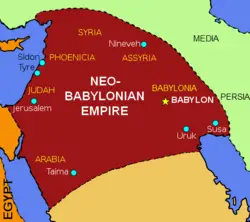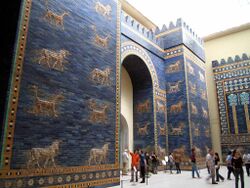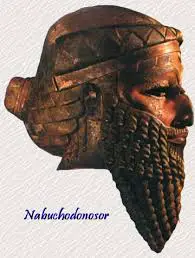How Did Nebuchadnezzar Impact Ancient Near Eastern History
Nebuchadnezzar II (ruled 604-562 BC), the second king of the Neo-Babylonian Empire, most commonly known just as “Nebuchadnezzar” in modern times, is one of the most important but also one of the most misunderstood leaders of the ancient world. Depicted as wantonly cruel in the Old Testament, it is a historical fact that he was responsible for taking the Kingdom of Judah into captivity and destroying the Solomonic Temple. With that said, Nebuchadnezzar II’s leadership style, policies, and tactics differed little from those of other notable kings in the same era. Once one cuts through some of the hyperbole surrounding Nebuchadnezzar II, it quickly becomes evident that he affected the ancient Near East in several profound ways.
Under Nebuchadnezzar II, Babylon once again became one of the greatest cities in the ancient world. It had languished for centuries under Assyrian rule, but Nebuchadnezzar II and the other Neo-Babylonian kings became the center of a new and vibrant empire. Much of Nebuchadnezzar II brought Babylon back to greatness through the conquest of other kingdoms, such as Judah. Still, he also embarked on an ambitious building program that made his city the envy of the ancient world.
The Neo-Babylonian Dynasty
The Neo-Babylonian Dynasty came to life through struggle and strife with its northern neighbor, Assyria. Babylon had long been the object of desire for many of the Near East empires and had been sacked by the Hittites and Elamites before the Assyrians placed the city directly under their control from 705-627 BC. Babylonian primary sources depict Assyrian rule as odious and oppressive, with the Assyrian King Sennacherib (ruled 704-681 BC) being seen as particularly cruel. Sennacherib was said to have let the temples fall into ruin and even removed Marduk's sacred cult statue, the patron god of Babylon, to Assyria. [1] Eventually, though, the Assyrians overextended their empire, allowing the Babylonians to form an alliance with the Medes and overthrow Assyrian rule.
Nabopolassar (reigned 626-605 BC) was the Babylonian king who expelled the Assyrians from the region, thereby establishing the Neo-Babylonian Dynasty and empire. Ancient Mesopotamia was comprised of many disparate and often conflicting ethnic groups, who, despite their differences, shared a common religion, as well as the Akkadian language. The Neo-Babylonians were of an ethnic group known as the Chaldeans, which is how the Bible's chroniclers referred to them. [2]
Before Nebuchadnezzar II became the second king of the Neo-Babylonian Dynasty, he was Nabopolassar’s oldest son and trusted general. As Nabopolassar sat on the throne in Babylon, Nebuchadnezzar led some successful military campaigns against the Egyptians in 605 BC at Carchemish and Hamath. Nebuchadnezzar’s victories over Egypt established the Neo-Babylonian Dynasty as a true empire, essentially taking most of the Assyrian Empire's land. The victories also helped ensure that Nebuchadnezzar II would be accepted by the Babylonian nobility, thereby guaranteeing a smooth transition to the throne. [3]
Nebuchadnezzar II’s Expansion of the Neo-Babylonian Empire
Not long after Nebuchadnezzar II became the king, he marched with his army back into the Levant to assert Babylonian supremacy in the region. According to the primary text known as the “Babylonian Chronicle,” the campaign was done for punitive reasons and a show of strength to any city thinking of either going to Egypt to support or assert their independence.
“The first year of Nebuchadnezzar (II): In the month Sivan he mustered his army and marched to Hattu. Until the month Kislev, he marched about victoriously in Hattu. All the kings of Hattu came into his presence, and he received their vast tribute. He marched to Ashkelon, and in the month Kislev, he captured it, seized its king, plundered and sacked it. He turned the city into a ruin heap. In the month Shebat, he marched away and returned to Babylon.” [4]
Babylon’s reasserted presence in the Levant under Nebuchadnezzar II did not sit well with Egypt, which had its imperial ambitions in the region. Seeking to establish a foothold in the Levant, the Egyptians aligned with Judah, setting the stage for a decisive battle between the Egyptians and Babylonians. In 605 BC, the Babylonian army led by Nebuchadnezzar II defeated the combined Egyptian-Judah army of pharaoh Nekau II (ruled 610-595 BC), making Judah and its king, Jehoiakim, a vassal of Babylon. [5] Jehoiakim played the role of a loyal vassal, but his two successors were not so appeasing toward Nebuchadnezzar II, which led to disastrous consequences for Judah as documented in both the Bible and Babylonian sources.
After Jehoiakim died in 597 BC, his son, Jehoiachin, became the king of Judah at age eighteen. According to II Kings 24:10-16, Jehoiachin and thousands of other Judeans were taken into captivity by Nebuchadnezzar II. The precise reason why Jehoiachin was removed is never clarified, but the event is corroborated in Babylonian chronicles.
“Year seven, month Kislimu: The king of Akkad moved his army into Hatti land, laid siege to the city of Judah, and the king took the city on the second day of the month Addaru. He appointed in it a (new) king of his liking, took heavy booty from it, and brought it into Babylon.” [6]
How did Nebuchadnezzar impact Judah (modern-day Israel)
Nebuchadnezzar II then appointed Zedekiah to be king of Judah because he would have presumably been more pliable, but it turned out that he was just as recalcitrant as his predecessors. Angered at the situation, Nebuchadnezzar II did what any ancient king of the Near East would have done – he invaded the kingdom, destroyed their most holy site, and took most of the population into captivity. The sacking of Jerusalem and the destruction of the Solomonic Temple took place in the year 586 BC. [7]
“And they slew the sons of Zedekiah before his eyes, and put out the eyes of Zedekiah, and bound him with fetters of brass, and carried him to Babylon. And in the fifth month, on the seventh day of the month, which is the nineteenth year of king Nebuchadnezzar king of Babylon, came Nebuzardan, a captain of the guard, a servant of the king of Babylon, unto Jerusalem. And he burnt the house of the Lord, and the king’s house, and all the houses of Jerusalem, and every great man’s house burnt he with fire. And all the Chaldeans' army, that was with the captain of the guard, brake down the walls of Jerusalem round bout. Now the rest of the people that were left in the city, and the fugitives that fell away to the king of Babylon, with the remnant of the multitude did Nebuzardan the captain of the guard carry away.” [8]
Jerusalem's sacking proved to be a defining moment in the history of Judaism, as important as the Exodus. Still, it was almost as important in the modern construction of Nebuchadnezzar II’s legacy. For centuries, Western scholars and theologians only knew Nebuchadnezzar II from the Old Testament books of II Kings and Daniel, so he, therefore, acquired the reputation as a cruel, bloodthirsty despot. Although the events described in II Kings certainly took place, the tactics Nebuchadnezzar II used to pacify rebellious peoples were the same as those employed by other powerful kingdoms of the time. The verses also do not mention how Nebuchadnezzar II brought the city of Babylon back to greatness.
Nebuchadnezzar II’s Building Projects
Once Nebuchadnezzar II had secured his dynasty’s empire's boundaries, he was free to pursue more peaceful endeavors in Babylon. For several decades before Nebuchadnezzar II came to power, Babylon had languished, with many of its once great monuments falling into ruin.
The central part of Babylon, which was on the Euphrates River banks, was remodeled in a truly extravagant manner. The king’s palace was built in the center of it all with the newly constructed Etemenanki Ziggurat – the ziggurat of the god Marduk and what was more than likely the inspiration for the “Tower of Babel” in Genesis 11: 1-9 – nearby. [9] Marking the way into Nebuchadnezzar II’s inner city was the famed Ishtar Gate, which was dedicated to Ishtar, the Mesopotamian goddess of love and war. The beautifully done gateway was made of glazed bricks and covered with numerous depictions of mythological bulls and dragons. [10]
Nebuchadnezzar was Important because he expanded and solidified the Neo-Babylonian Empire
In the centuries after the collapse of the Neo-Babylonian Empire, Nebuchadnezzar II’s reputation progressively worsened, thanks in large part to his portrayal in the Old Testament. Although many of the biblical passages that relate to Nebuchadnezzar II are true, especially those in II Kings, the fact remains that he was a significant figure in the ancient Near East.
Nebuchadnezzar II was a great conqueror who established a Near Eastern empire that was essentially the Assyrian Empire's geographical equivalent. Still, perhaps just as important were his building activities. Through his ambitious building program, the Babylonian king made sure that his city would once again become one of the greatest in the ancient world and that even more than 2,000 years later, people would still view some of those monuments with awe.
References
- ↑ Kuhrt, Amélie. The Ancient Near East: c. 3000-330 BC. (London: Routledge, 2010), pgs. 582-85
- ↑ Kuhrt, p. 575
- ↑ Kuhrt, p. 590
- ↑ Grayson, A. Kirk, ed. Assyrian and Babylonian Chronicles. (Winona Lake, Indiana: Eisenbrauns, 2010), p. 100
- ↑ Kitchen, Kenneth A. On the Reliability of the Old Testament. (Grand Rapids, Michigan: William B. Eerdmans, 2003), p. 44
- ↑ Pritchard, James B, ed. Ancient Near Eastern Texts Relating to the Old Testament. 3rd ed. (Princeton, New Jersey: Princeton University Press, 1992), p. 564
- ↑ Kitchen, p. 45
- ↑ II Kings 25:1-11
- ↑ Frankfort, Henri. The Art and Architecture of the Ancient Orient. (New Haven, Connecticut: Yale University Press, 1996), p. 203
- ↑ Frankfort, p. 205
Admin and Jaredkrebsbach
Updated December 4, 2020


